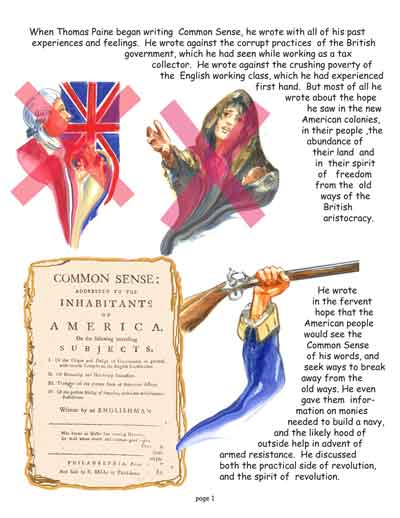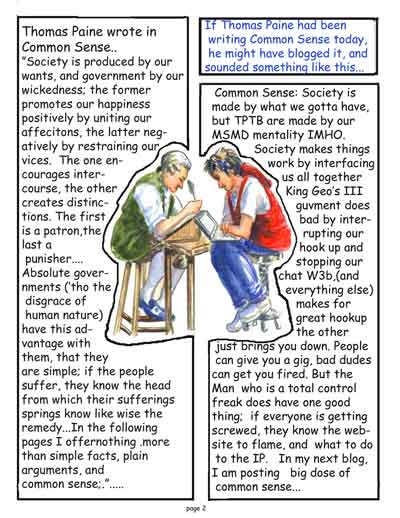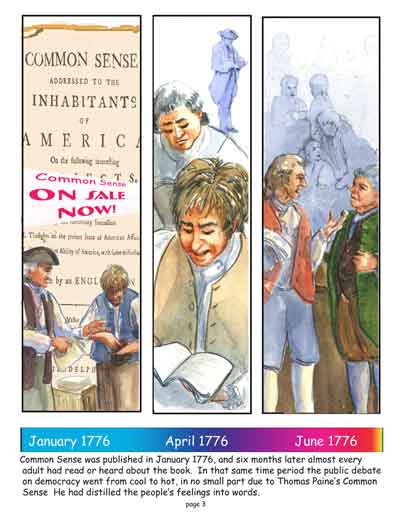


Alison Davis Lyne's
Sequential Short on Thomas Paine
by Alison Davis Lyne
|
|
|
|
These three pages are a second in an ongoing series I'm doing called "Revolutionary Moments in Time". They consist of small three to six page vignettes of snapshots of moments in history. They are based in a large part on primary sources, i.e. writings from the time period. These sources are either autobiographical or actual published papers/books/pamphlets by the main figures. I also read current day commentaries about these historic individuals. In reading Common Sense by Thomas Paine, I was first looking for a visual "hook" to start the drawing process. Instead I found my self becoming very interested in the substance of Tom Paine's words. It takes very little changes in the names of the people/governments mentioned in this work, to make it very relevant today! I am reminded again, why some works are considered "spanning the years", and why Common Sense falls into that category even today.
The following brief biography is some background information that gives a bit of the "taste" of Tom Paine's life and times. It in part gives some of the experiences that inspired the writing of Common Sense.
Thomas Paine was born 1/29/1737 in Thetford,England. His parents were Anglican and then Quakers. In England, the government also collected taxes to support the Anglican Church (i.e. A state supported Church, since English Henry VIII started it.) He learned, grudgingly, his father's trade of corset making. He ran away twice attempting to ship out aboard a privateer. The second time, at 16, he succeeded, and stayed at sea for a year or so. Then he went to London. To escape the inability to better himself he must have often visited and drunk in the seedier side of town, Gin Mill. At 22 he married a serving girl, had a child, and both the mother and child died soon after. At 25 he became a tax collector, an occupation worse hated than dog catcher. A second marriage to a widowed girl with a failing shop, led to his first writings; (1772) The Case of the Officers of the Excise, an attempt at a rudimentary "union" of tax collectors, to get higher wages. Then, in 1774 the second marriage dissolved, and Thomas, broke and discouraged, drowned his sorrows in the Gin Mill section of London. When he emerged, he had passage to America, and a letter of introduction from Ben Franklin, who was visiting England at the time.
In 1775 he arrived in America, and got a job in Philadelphia at the Pennsylvania Magazine. He began writing articles against British oppression of the Colonies. His writings weren't abstract ideals, they were more an urgent call to action, and a path for those actions to follow, to a desired end for betterment of all people.After leaving the Pennsylvania Magazine he began writing Common Sense.
When Thomas Paine started writing Common Sense, he wrote with all of his past experiences and feelings. He wrote against the corrupt practices of the British government, which he had seen while working as a tax collector. He wrote against the crushing poverty of the English working class, which he had experienced first hand. But most of all he wrote about the hope he saw in the new American colonies, in their people, the abundance of their land and in their spirit of freedom from the old ways of the British aristocracy. He wrote in the fervent hope that the American people would see the Common Sense of his words, and seek avenues to break away from the old ways. He even gave them information on monies needed to build a navy, and the likely hood of outside help in the advent of armed resistance. He discussed both the practical side of revolution, and the spirit of revolution.
When Thomas Paine finished writing Common Sense, he published it with his friend from thePennsylvania Magazine.
Common Sense was published in January 1776, and six months later almost every adult had read or heard about the book. In that same time the public debate on democracy went from cool to hot, in no small part due to Thomas Paine's Common Sense. He had distilled the people's feelings into words.
Below are a few of the sources used to put together these three pages.
Bibliography
Woodward, WT, Tom Paine: American's Godfather 1737-1809 , 1945, E P Dutton & Cor Fast, Howard,
The Selected Work of Tom Paine & Citizen Tom Paine , The Modern Library-Random House USA
Burgun, Michael, Thomas Paine, 2005, Compass Point Books, Minneapolis, MN
Fish, Becky Durost, Thomas Paine, 2000, Chelsea House Publishers, New York, NY
Warren, Mercy Otis, History of the Rise, Progress, and Termination of the American Revolution , 1805, Manning & Loring for E. Larkin
http://www.netlingo.com/emailsh.cfm
If you have comments or suggestions about this page, please write at alison@lyneart.com
Return to ---Alison Lyne illustrations– Frank Lyne Sculptures– Lyneart main page